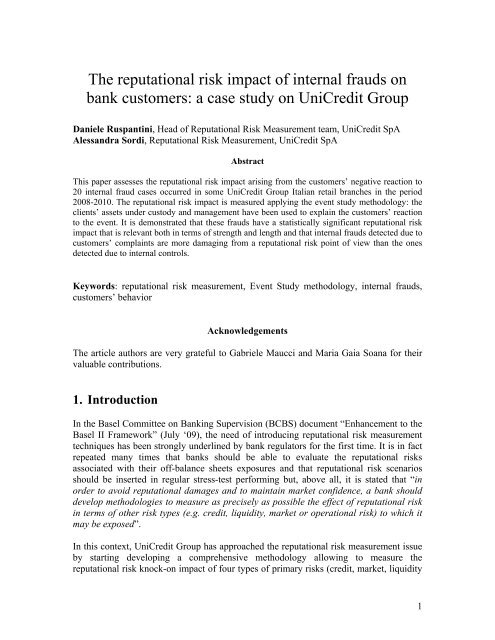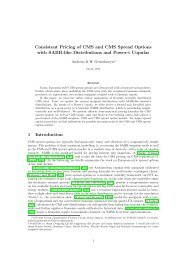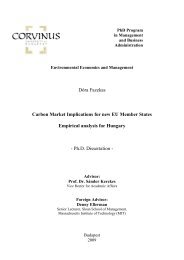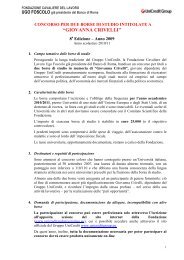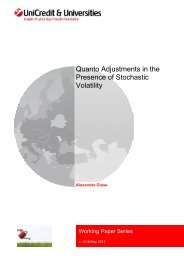A Comprehensive Framework for Reputational Risk Management
A Comprehensive Framework for Reputational Risk Management
A Comprehensive Framework for Reputational Risk Management
Create successful ePaper yourself
Turn your PDF publications into a flip-book with our unique Google optimized e-Paper software.
The reputational risk impact of internal frauds on<br />
bank customers: a case study on UniCredit Group<br />
Daniele Ruspantini, Head of <strong>Reputational</strong> <strong>Risk</strong> Measurement team, UniCredit SpA<br />
Alessandra Sordi, <strong>Reputational</strong> <strong>Risk</strong> Measurement, UniCredit SpA<br />
Abstract<br />
This paper assesses the reputational risk impact arising from the customers’ negative reaction to<br />
20 internal fraud cases occurred in some UniCredit Group Italian retail branches in the period<br />
2008-2010. The reputational risk impact is measured applying the event study methodology: the<br />
clients’ assets under custody and management have been used to explain the customers’ reaction<br />
to the event. It is demonstrated that these frauds have a statistically significant reputational risk<br />
impact that is relevant both in terms of strength and length and that internal frauds detected due to<br />
customers’ complaints are more damaging from a reputational risk point of view than the ones<br />
detected due to internal controls.<br />
Keywords: reputational risk measurement, Event Study methodology, internal frauds,<br />
customers’ behavior<br />
Acknowledgements<br />
The article authors are very grateful to Gabriele Maucci and Maria Gaia Soana <strong>for</strong> their<br />
valuable contributions.<br />
1. Introduction<br />
In the Basel Committee on Banking Supervision (BCBS) document “Enhancement to the<br />
Basel II <strong>Framework</strong>” (July ‘09), the need of introducing reputational risk measurement<br />
techniques has been strongly underlined by bank regulators <strong>for</strong> the first time. It is in fact<br />
repeated many times that banks should be able to evaluate the reputational risks<br />
associated with their off-balance sheets exposures and that reputational risk scenarios<br />
should be inserted in regular stress-test per<strong>for</strong>ming but, above all, it is stated that “in<br />
order to avoid reputational damages and to maintain market confidence, a bank should<br />
develop methodologies to measure as precisely as possible the effect of reputational risk<br />
in terms of other risk types (e.g. credit, liquidity, market or operational risk) to which it<br />
may be exposed”.<br />
In this context, UniCredit Group has approached the reputational risk measurement issue<br />
by starting developing a comprehensive methodology allowing to measure the<br />
reputational risk knock-on impact of four types of primary risks (credit, market, liquidity<br />
1
and operational risk) on four stakeholder categories (customers, investors, employees and<br />
institutional counterparties).<br />
The analysis which is shown in this paper is inserted in this context: the focus is on the<br />
customer stakeholders’ category and the aim is to evaluate the strength and length of the<br />
reaction that internal frauds perpetrated at bank retail branches provoke on clients. Such<br />
reaction might in fact result in the bank lack of capability in maintaining the existing or<br />
establishing new business opportunities: the reputational risk impact of the event.<br />
The article is structured as follows: section two provides a brief overview on the literature<br />
context which the article belongs to; section three details the methodology applied;<br />
section four describes the sample that is used in the per<strong>for</strong>med empirical analyses; section<br />
five reports the analyses results and the related comments; section six briefly summarizes<br />
the article most important considerations.<br />
2. Context<br />
This paragraph provides some brief considerations on the reference context <strong>for</strong> the<br />
per<strong>for</strong>med analyses: readers who are interested in deepening this topic may refer to the<br />
articles which are quoted in the bibliography.<br />
Be<strong>for</strong>e the change in regulators’ perspective which has been mentioned in the article<br />
introduction, operational risk was deemed the most important source <strong>for</strong> the reputational<br />
one. For this reason contributions from financial literature have focused on the<br />
reputational losses arising from the operational losses announcements <strong>for</strong> listed<br />
companies. The reputational losses were evaluated on the companies market<br />
capitalization meaning that the stakeholder category investors was taken into account.<br />
Looking very quickly to the findings of some of the latest analyses per<strong>for</strong>med in this<br />
context, Cummins, Lewis and Wei (2006) studying the impact on the market value of<br />
American banks and American insurance companies found out that reputational losses<br />
are more marked <strong>for</strong> insurances than <strong>for</strong> banks; De Fontnouvelle and Perry (2005)<br />
detected that reputational losses are particularly relevant <strong>for</strong> banks characterized by<br />
strong shareholders’ right; Schwizer, Soana, Maucci, Ruspantini (2010) analyzing <strong>for</strong> the<br />
first time five out of the seven regulatory operational risk event types highlighted that the<br />
most relevant reputational losses are suffered with external frauds and more over that<br />
small operational losses can lead to reputational damages equal to and in some cases<br />
slightly greater than, those of the higher operational losses (the threshold between the two<br />
classes is set to 10 millions USD $)<br />
The aim of this article is to start overcoming these limits: operational risk is still<br />
considered but the reputational risk impact is evaluated keeping into consideration the<br />
customers’ stakeholders category. The article authors hope this can be the starting point<br />
<strong>for</strong> a number of analyses by financial practitioners and academics taking into account all<br />
the different aspects of reputational risk (e.g. different primary risks and/or different<br />
stakeholder categories).<br />
2
3. Methodology<br />
As already mentioned this paper aims to evaluate the reputational risk impact arising<br />
from the customers’ negative reaction to 20 internal fraud cases occurred in some<br />
UniCredit Group Italian retail branches in the period 2008-2010. This impact is evaluated<br />
in terms of the strength of the reaction that customers show to the event and in terms of<br />
the length of this reaction: in the UniCredit <strong>Reputational</strong> <strong>Risk</strong> Measurement framework<br />
these are referred to as Intensity of the customers’ reaction and Time to Reputation<br />
Recovery 1 .<br />
3.1. The considered variables<br />
The articles, which have been already mentioned in the previous paragraph, evaluate the<br />
“reputational losses” that listed companies suffer on the market as a consequence of the<br />
announcement of relevant operational losses. They investigate in fact the stock return<br />
changes resulting from the announcement of operational losses: the registration of any<br />
returns significantly differing from the predicted ones is interpreted as an anomaly to be<br />
attributed to the new in<strong>for</strong>mation made available to the market. It can thus be concluded<br />
that they measure the reputational risk impact of these events taking into consideration<br />
only the stakeholder category investors 2 .<br />
The proposed analysis wants instead to investigate the reaction of the stakeholder<br />
category customer. A different variable is thus needed, allowing to describe the behaviour<br />
of customers over time and sufficiently “sensible” to catch any reaction that customers<br />
might have as a consequence of an internal fraud event. The assets under custody and<br />
management (hereafter AUC&M) have been chosen: <strong>for</strong> each considered case: the total<br />
AUC&M of the branch where the fraud has been perpetrated is chosen as explanatory<br />
variable while the total AUC&M of the geographical area the branch belongs to (i.e. the<br />
sum of the total AUC&M of all the branches of the geographical area where the<br />
defrauded branch is located) is considered as benchmark. It has been chosen to consider<br />
as explanatory variable the AUC&M of all the customers of the impacted branch and not<br />
only the AUC&M of the defrauded clients as it is deemed that reputational risk is<br />
particularly damaging when a sort of contagion effect makes the number of stakeholders<br />
(within a chosen stakeholder category) reacting to the primary event higher than the<br />
number of the impacted ones.<br />
The data used in the analysis were available on a monthly basis. This is a huge difference<br />
with the analyses investigating the reactions of the market where daily data are available.<br />
A couple of consideration shall thus be made. From a practical point of view, the<br />
adoption of monthly data is considered a proper choice to describe the customers’<br />
1<br />
It shall be underlined these represent only two out of the five factors which UniCredit <strong>Reputational</strong> <strong>Risk</strong><br />
Measurement and Control uses to evaluate the reputational risk impact of events. The five factors are: the<br />
degree of the exposure to the primary risk, the probability of the trigger event, the intensity of the<br />
stakeholder reaction, the event amplifier factor and the time to reputation recovery<br />
2<br />
More in details, “markets” are only one of the components of the stakeholder category investors (e.g.<br />
shareholders)<br />
3
eaction: customers in fact need time to be aware of an event, get a sense of it and<br />
coherently react, thus eventual changes in their behaviours cannot be appreciated with<br />
short period variable (e.g. daily variables). From the statistical point of view instead, the<br />
usage of monthly data makes more questionable the robustness of the achieved results: a<br />
lower number of observations is in fact available <strong>for</strong> the regression analysis as it is not<br />
possible to go too far back in time without the risk of including in the analysis some<br />
distortion elements. By the way, as a practitioner approach wants to be followed, the<br />
positive considerations on the capability and reasonableness in describing the customers’<br />
behaviours have prevailed on the concerns about the statistical robustness.<br />
3.2. Methodology description<br />
Accordingly with the studies already quoted, Event Study Methodology has been applied:<br />
by comparing the values of AUC&M effectively experienced in the branch with the ones<br />
which would have been experienced if the event had not happened, it allows to detect if<br />
customers show an abnormal reaction when they are hit by the fraud events. The<br />
existence of an abnormal trend <strong>for</strong> their AUC&M is then interpreted as the reputational<br />
risk impact of the event.<br />
For each considered event i, the “normal” behavior of the branch AUC&M variable has<br />
been estimated applying the market model:<br />
R i,<br />
t = α i + β i ∗ Rmk<br />
_ i,<br />
t + ε i,<br />
t<br />
where<br />
� Ri,t is the logarithmic return of the explanatory variable (AUC&M of the branch)<br />
� Rmk_i,t is the logarithmic return of the benchmark (AUC&M of the geographical<br />
area)<br />
� αi and βi are the linear model coefficients estimated with the Ordinary Least<br />
Squares regression<br />
� εi,t is the residual of the model, that is the part of Ri,t which could not be explained<br />
by the benchmark; <strong>for</strong> hypothesis it iid~N(0, σ 2 i).<br />
This market model is per<strong>for</strong>med <strong>for</strong> each event i on a pre-event window including a<br />
number of observations varying from 12 to 24 be<strong>for</strong>e the chosen event window. The<br />
event window is the interval ranging between -τ 1 months be<strong>for</strong>e andτ 2 months after the<br />
event (the time t=0 representing the event discovering date is also comprised) in which<br />
the event reputational consequences are evaluated.<br />
It shall be noted that the pre-event windows of the different cases have different lengths,<br />
depending on data availability: the lower and upper limits <strong>for</strong> the range (respectively 12<br />
and 24 months) are set considering that less than 12 observations are deemed not<br />
sufficient to obtain statistical relevant considerations, and that including more than two<br />
years can add some distortion factors in the model estimation. The statistical significance<br />
of the market model has been tested considering the R 2 values and verifying the<br />
stationarity of the logarithmic returns time series of both the explanatory variable and<br />
benchmark: positive results have been obtained.<br />
4
More over, it wants to be underlined that three types of event windows have been<br />
considered: the ones preceding the event, the ones <strong>for</strong>egoing the event and the ones<br />
including months both be<strong>for</strong>e and after the event. The event windows of the first type<br />
have been taken into account as they allow to study if reputational consequences are<br />
suffered even be<strong>for</strong>e the bank officially recognizes the fraud.<br />
The evidences of the market model are then used in a predictive way to determine the<br />
Abnormal Returns AR(t) at each time t in the event window [-τ 1 , τ 2 ]. The Abnormal<br />
Returns are defined as the differences between the really experienced AUC&M values <strong>for</strong><br />
every month t, Rt*, and the values calculating using the coefficients αi and βi estimated<br />
with the market model:<br />
*<br />
*<br />
ARi ( t)<br />
= Ri,<br />
t −α<br />
i − βi<br />
* Rmk<br />
_ i,<br />
t<br />
where the symbol * means that only data in the event window are considered.<br />
For each event i, the Cumulative Abnormal Returns are then evaluated as the sum of<br />
consecutive Abnormal Returns in the chosen interval [- τ ]:<br />
CAR ( t)<br />
=<br />
i ∑<br />
s=<br />
1<br />
AR ( s)<br />
τ 1 , 2<br />
The average CAR (CAR ) time series is instead obviously defined as<br />
n 1<br />
CAR(<br />
τ 1 , τ 2 ) = ∑ CARi<br />
( τ 1,<br />
τ 2 )<br />
n i=<br />
1<br />
where n is the total number of cases under consideration.<br />
The statistical significance of the achieved results has been studied by considering the<br />
one tail test which has been originally presented by Campbell, Lo and Mackinley (1997)<br />
and which verifies the null hypothesis whereby the event has no influence on the<br />
cumulated returns. The considered statistic is thus<br />
( 2<br />
T =<br />
2<br />
where σˆ τ1,<br />
τ ) is the estimated variance of the CAR time series.<br />
This test is based on the assumption of the normal distribution <strong>for</strong> both AR and CAR time<br />
series: the Jarque Bera test has been per<strong>for</strong>med to investigate this hypothesis. As it will<br />
be shown in paragraph 5, the normal distribution condition is always respected.<br />
4. Sample description<br />
t<br />
( 1 2 )<br />
( τ , τ )<br />
τ , τ<br />
CAR<br />
2 [ σˆ ]<br />
1<br />
2<br />
i<br />
1 / 2<br />
≈<br />
N<br />
( 0,<br />
1)<br />
The analysis has been per<strong>for</strong>med on a sample of 20 internal frauds which have been<br />
extracted from the official UniCredit database <strong>for</strong> operational risk according to the<br />
following criteria:<br />
5
1. the internal fraud has occurred in a retail branch;<br />
2. the event has happened in the Italian perimeter and its observation date (the date<br />
in which the event has been officially discovered by the company) is comprised<br />
between the last quarter of 2008 and the first quarter of 2010;<br />
3. more than a customer has been affected by the fraud event;<br />
4. the operational loss has an amount higher than € 50.000.<br />
The first two criteria aim to define and limit the application scope of the analysis in terms<br />
of the type of stakeholder investigated (mass market customers) and in terms of the<br />
geographical region the stakeholder belongs to (Italy) and the time where his/her<br />
behavior is investigated.<br />
The last two criteria are instead introduced to describe the relation (“trigger”) between<br />
the primary risk event (in this case an operational one) and the secondary reputational<br />
risk impact. These two criteria have been chosen by the articles’ authors <strong>for</strong> their<br />
reasonableness. It is in fact easy to understand that<br />
1. customers may be more sensible to primary events directly hurting them rather<br />
than to primary events not impacting on them (i.e. an internal fraud where money<br />
is embezzled from clients is considered more damaging from a reputational risk<br />
point of view than an internal fraud where a branch employee steals cash from the<br />
deposit vault)<br />
2. the higher is the amount of the primary loss, the higher is the coverage which<br />
might be potentially granted to the event by the media (even at local level), this<br />
potentially increasing the set of the stakeholder that being aware of the event<br />
might react to it (e.g. if an internal fraud event is reported by media, also the<br />
branch customers who have not been affected are aware of it and thus can react to<br />
it).<br />
In Table 1, some statistics about the considered operational losses are reported (values are<br />
expressed in Euro):<br />
Table 1: operational losses statistics<br />
Min 53.500<br />
Max 3.568.000<br />
Average 756.606<br />
Median 358.900<br />
Standard Deviation 1.020.211<br />
As already stated in paragraph 3.1, <strong>for</strong> each one of the detected cases the monthly time<br />
series of the total AUC&M of the branch where the event has occurred and of the total<br />
AUC&M of the branches of the geographical area to which the defrauded one belongs<br />
have been considered. Please note again that the benchmark is described by the sum of<br />
this second set of monthly total AUC&M.<br />
6
5. Results<br />
The analysis of the considered data, has thus allowed to evaluate the reputational risk<br />
impact arising from the customers reaction to the internal fraud events which have been<br />
selected. It is considered that a reputational risk impact exists when a statistically<br />
significant negative value <strong>for</strong> the CAR is obtained.<br />
The analysis has been per<strong>for</strong>med at two different level:<br />
• the cases have been investigated altogether<br />
• the cases have been divided in two samples, the internal frauds discovered due to<br />
customers complaints and the ones discovered due to internal control. This has<br />
been done to detect if a statistical evidence can be found <strong>for</strong> the hypothesis that<br />
the internal fraud cases which are detected by customers are potentially more<br />
damaging <strong>for</strong> the bank from a reputational risk point of view than the ones which<br />
are detected due to internal controls.<br />
The results of the first exercise (data investigated altogether) are reported in Table 2: the<br />
columns respectively represent the investigated event window, the number of considered<br />
cases, the CAR , the value of the statistic T and the p-value of the Jarque Bera test.<br />
Table 2: reputational risk impact on customers of internal frauds<br />
Event window N. cases CAR<br />
T<br />
Jarque Bera<br />
test (p-value)<br />
[-3; 0] 20 -0.031 -1.906** 0.848<br />
[-3; 3] 20 -0.063 -2.678*** 0.711<br />
[-3; 5] 20 -0.077 -2.709*** 0.665<br />
[-3; 7] 20 -0.082 -2.504*** 0.587<br />
[0; 1] 20 -0.024 -2.241** 0.846<br />
[0; 3] 20 -0.041 -2.525*** 0.835<br />
[0; 5] 20 -0.055 -2.563*** 0.824<br />
[0; 7] 20 -0.061 -2.311** 0.707<br />
* Statistically significant at 10% (one-tailed test)<br />
** Statistically significant at 5% (one-tailed test)<br />
*** Statistically significant at 1% (one-tailed test)<br />
Table 2 shows that a statistically significant reputational risk impact (negative CAR ) is<br />
detected <strong>for</strong> each considered event window: more in detail the CAR in the event<br />
windows [-3;0], [0;1], [0:7] are statistically significant at 5% while the average CAR in<br />
the event windows [-3;3], [-3;5], [-3;7], [0;3], [0;5] are statistically significant at 1%.<br />
Quite surprisingly, a reputational risk impact is even detected in the event window [-3;0],<br />
this meaning that customers starts reacting be<strong>for</strong>e the event is officially recognized by the<br />
bank.<br />
7
It shall also be noted that both the event windows of the type [-3,x] and the ones of the<br />
type [0,x] track an increasing trend <strong>for</strong> the CAR (see figure 1 <strong>for</strong> the second type): this<br />
means that the customers’ reaction becomes more severe with the passing of time. More<br />
over, considering that <strong>for</strong> both the event window types, the increasing trend is not ended<br />
with the last available observation, it has to be concluded that, on average, seven months<br />
after the event detection the bank has not yet been able to stop the negative consequences.<br />
Thus, considering that the effect seems starting three months be<strong>for</strong>e the event detection<br />
(the analysis was not repeated <strong>for</strong> previous months as it seemed that otherwise too few<br />
data would have been used in the market model) it can be concluded that the reputational<br />
risk impact lasts at least <strong>for</strong> 11 months.<br />
Figure 1: CAR trend<br />
Considering now the second part of the analysis, Table 3 and 4 show the results<br />
respectively <strong>for</strong> the cases the fraud is detected due to internal control and the fraud is<br />
detected due to customers complaints.<br />
8
Table 3: fraud detected due to internal control<br />
Event window N. cases CAR<br />
T<br />
Jarque Bera<br />
test (p-value)<br />
[-3; 0] 10 -0.011 -1.146 0.768<br />
[-3; 3] 10 -0.021 -1.497* 0.684<br />
[-3; 5] 10 -0.034 -2.018** 0.605<br />
[-3; 7] 10 -0.027 -1.428* 0.615<br />
[0; 1] 10 -0.005 -0.756 0.846<br />
[0; 3] 10 -0.008 -0.874 0.75<br />
[0; 5] 10 -0.021 -1.682** 0.871<br />
[0; 7] 10 -0.015 -0.988 0.791<br />
* **<br />
Statistically significant at 10% (one-tailed test) Statistically significant at 5% (one-tailed test)<br />
***<br />
Statistically significant at 1% (one-tailed test)<br />
Table 4: fraud detected due to customers’ complaints<br />
Event window N. cases CAR T<br />
Jarque Bera<br />
test (p-value)<br />
[-3; 0] 10 -0.051 -1.641** 0.875<br />
[-3; 3] 10 -0.105 -2.340*** 0.738<br />
[-3; 5] 10 -0.120 -2.214** 0.653<br />
[-3; 7] 10 -0.138 -2.183** 0.605<br />
[0; 1] 10 -0.044 -2.112** 0.846<br />
[0; 3] 10 -0.074 -2.373*** 0.85<br />
[0; 5] 10 -0.089 -2.163** 0.766<br />
[0; 7] 10 -0.107 -2.115** 0.745<br />
* **<br />
Statistically significant at 10% (one-tailed test) Statistically significant at 5% (one-tailed test)<br />
***<br />
Statistically significant at 1% (one-tailed test)<br />
The two tables show that while in the case the fraud is detected due to customers’<br />
complaints a statistically significant reputational risk is observed <strong>for</strong> each considered<br />
event window, in the case the fraud is detected due to internal control only the event<br />
window [-3;3], [-3;5], [-3;7] and [0;5] are statistically significant (the first and the third<br />
one at the 10%, the other ones at the 5%).<br />
The obtained CAR are different not only <strong>for</strong> their statistical significance but also <strong>for</strong> their<br />
values. While in the internally detected case the four statistical significant values range<br />
between -0.021 and -0.034 <strong>for</strong> the customers’ complaints detected case the average CAR<br />
values range between -0.044 and -0.138.<br />
Thus the hypothesis to be tested seems confirmed: as both the values and the statistical<br />
significance of CAR are higher in the case the fraud is detected due to customers’<br />
complaints, it seems possible to conclude that this kind of internal frauds is more<br />
damaging from a reputational risk point of view than the internal detected ones.<br />
9
A last consideration regards the bank possibility to recover its reputation: looking at<br />
Tables 3 and 4 and at Figure 2 and 3 it is in fact possible to understand that while in the<br />
customers’ complaints case the negative increasing CAR trend is not finished at the end<br />
of the seventh month after the event detection (the last data available), in the internal<br />
detected case the negative increasing CAR trend stops at the end of the fifth month after<br />
the event detection. This seems to underline that in the case the fraud is internally<br />
discovered it is possible <strong>for</strong> the bank to soften the reputational risk impact not only in<br />
terms of strength of the customer reaction but also in terms of the time which is needed to<br />
recover its pre-event reputation level. On the other side instead it seems that when the<br />
internal fraud is discovered due to customers’ complaints it is not anymore possible <strong>for</strong><br />
the bank to recover the pre-event reputation level (at least on a year time horizon)<br />
meaning that the relationship of trust with customers is structurally compromised.<br />
Figure 2: CAR trend <strong>for</strong> the internal detected frauds<br />
10
Figure 3: CAR trend <strong>for</strong> the customers’ complaints detected frauds<br />
6. Conclusion<br />
The article wants to evaluate the reputational risk impact arising from the customers’<br />
negative reaction to 20 internal fraud cases occurred in some UniCredit Group Italian<br />
retail branches in the period 2008-2010. Cases have been selected as they respect some<br />
reputational risk “trigger criteria” (see paragraph 4). The reputational risk impact (to be<br />
expressed in terms of business capability) has been evaluated in terms of strength and<br />
length of the customers’ reaction to the event: the assets under custody and management<br />
have been chosen to describe them.<br />
The per<strong>for</strong>med analysis has first of all allowed to detect that these internal frauds have<br />
produced a relevant reputational risk impact. More in detail, the reputational risk impact<br />
starts three months be<strong>for</strong>e the event is officially recognized by the bank and it is still<br />
increasing at the end of the seventh month after it (the last data available <strong>for</strong> the analysis).<br />
It can thus be concluded that the bank is not able to recover its pre-event reputation level<br />
(with regards to customers) in a one year time horizon.<br />
The second part of the analysis aims to compare the frauds detected due to customers’<br />
complaints with the ones discovered due to internal controls as it is considered that the<br />
11
first ones are more damaging from a reputational risk perspective. The per<strong>for</strong>med<br />
analysis confirms this hypothesis: while <strong>for</strong> the first group obtained results are higher<br />
than in the case where all the frauds have been considered, <strong>for</strong> the second group results<br />
are statistically significant only in few cases and with a very low value.<br />
A final consideration that needs to be underlined regards the bank capability of restoring<br />
the pre-event level of reputation in terms of outstanding level of business. While in the<br />
case the fraud is internally discovered a recovery of the pre-event level of reputation<br />
seems tracked, in the other case it seems not possible <strong>for</strong> the bank to recover the preevent<br />
relationship of trust with customers at least on a one year time horizon.<br />
In the end, just a couple of brief considerations on the fields of possible development <strong>for</strong><br />
this kind of analysis. The authors think in fact that useful enhancements might be<br />
achieved by considering other kinds of variables to describe the customers reaction<br />
and/or by refining the reputational risk “trigger criteria” which are used to select the<br />
events to be investigated.<br />
12
References<br />
[1] Basel Committee on Banking Supervision (2009), “Enhancements to the Basel<br />
II <strong>Framework</strong>”<br />
[2 ] Campbell J., Lo A., MacKinlay A.C. (1997), “The econometrics of financial<br />
markets”, Princeton University Press, Princeton<br />
[3] Cummins J.D., Lewis C.M., Wei R. (2006), “The market value impact of operational<br />
risk events <strong>for</strong> U.S. banks and insurers”, Journal of Banking and Finance, vol. 30,<br />
pages. 2605-2634<br />
[4] De Fontnouvelle P., Perry J. (2005), “Measuring reputational risk: the market<br />
reaction to operational loss announcements”, Working paper, Federal Reserve Bank<br />
of Boston<br />
[5] MacKinlay A.C. (1997) “Event studies in Economics and Finance”, Journal of<br />
Economic Literature, vol 35, pages 13-39<br />
[6] Schwizer P., Soana M.G., Maucci G., Ruspantini D. (2010), “Misurazione e controllo<br />
del rischio reputazionale”, Bancaria, year 66, vol 11, pages 27-48<br />
13


